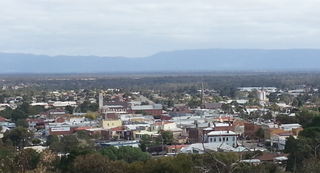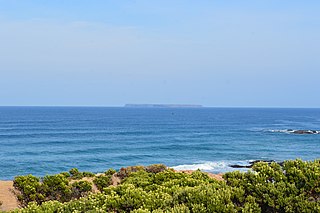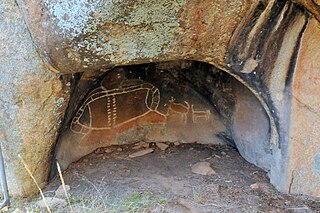


Bunjil, also spelt Bundjil, is a creator deity, culture hero and ancestral being, often depicted as a wedge-tailed eagle in Australian Aboriginal mythology of some of the Aboriginal peoples of Victoria.



Bunjil, also spelt Bundjil, is a creator deity, culture hero and ancestral being, often depicted as a wedge-tailed eagle in Australian Aboriginal mythology of some of the Aboriginal peoples of Victoria.
In the Kulin nation in central Victoria he was regarded as one of two moiety ancestors, the other being Waang the crow. Bunjil (or Bundjil [1] ) has two wives and a son, Binbeal the rainbow. His brother is Palian the bat. He is assisted by six wirmums or shamans who represent the clans of the Eaglehawk moiety: Djart-djart the nankeen kestrel, Thara the quail hawk, Yukope the parakeet, Lar-guk the parrot, Walert the brushtail possum and Yurran the gliding possum.[ citation needed ]
A Boonwurrung story tells of a time of conflict among the Kulin nations, when people argued and fought with one another, neglecting their families and the land. The mounting chaos and disunity angered the sea, which began to rise until it had covered the plains and threatened to flood the entire country. The people went to Bunjil and asked him to help them stop the sea from rising; Bunjil agreed to do so, but only if the people would change their ways and respect the laws and each other. He then walked out to the sea, raised his spear and ordered the water to stop rising. [2]
According to one legend, after creating the mountains, rivers, flora, fauna, and laws for humans to live by, Bunjil gathered his wives and sons then asked Waang, who had charge of the winds, to open his bags and let out some wind. Waang opened a bag in which he kept his whirlwinds, creating a cyclone which uprooted trees. Bunjil asked for a stronger wind. Waang complied, and Bunjil and his people were blown upwards into the sky. Bunjil himself became the star Altair and his two wives, the black swans, became stars on either side. [3] Bunjil was said to have left this world via the island of Deen Maar. [4]
It is believed by the Kulin and other Aboriginal peoples that, in the Dreamtime, Bunjil took shelter in a cave located in the part of Gariwerd that is now known as the Black Range Scenic Reserve, not far from Stawell. Bunjil's Shelter is today a popular tourist attraction and one of the most important Aboriginal rock art sites in the region. [5] [6] [7]
Early European colonists such as Daniel Bunce recorded the name as "Winjeel" or "Wingeel", [8] possibly from dialectal differences between the closely related Woiwurrung, Boonwurrung and Wathaurong languages. These spellings have persisted in the name of the farming area of Wingeel near Geelong, [9] and in that of the CAC Winjeel aircraft. [10]
In other sources, the name may be recorded as Pundjel, Bunjel, Pundjil, Punjel, Pun-Gel, Bun-Gil, or Pundgel. [11]

The Grampians National Park commonly referred to as the Grampians, is a national park located in the Grampians region of Victoria, Australia. The Jardwadjali name for the mountain range itself is Gariwerd.

Port Phillip or Port Phillip Bay is a horsehead-shaped enclosed bay on the central coast of southern Victoria, Australia. The bay opens into the Bass Strait via a short, narrow channel known as The Rip, and is completely surrounded by localities of Victoria's two largest cities — metropolitan Greater Melbourne in the bay's main eastern portion north of the Mornington Peninsula, and the city of Greater Geelong in the much smaller western portion north of the Bellarine Peninsula. Geographically, the bay covers 1,930 km2 (750 sq mi) and the shore stretches roughly 264 km (164 mi), with the volume of water around 25 km3 (6.0 cu mi). Most of the bay is navigable, although it is extremely shallow for its size — the deepest portion is only 24 m (79 ft) and half the bay is shallower than 8 m (26 ft). Its waters and coast are home to seals, whales, dolphins, corals and many kinds of seabirds and migratory waders.

The Wurundjeripeople are an Australian Aboriginal people of the Woiwurrung language group, in the Kulin nation. They are the traditional owners of the Yarra River Valley, covering much of the present location of Melbourne. They continue to live in this area and throughout Australia. They were called the Yarra tribe by early European colonists.

Stawell ( "stall"), is an Australian town in the Wimmera region of Victoria 237 kilometres (147 mi) west-north-west of the state capital, Melbourne. Located within the Shire of Northern Grampians local government area, it is a seat of local government for the shire and its main administrative centre. At the 2021 census, Stawell had a population of 6,220.
The Boonwurrung, also spelt Bunurong or Bun wurrung, are an Aboriginal people of the Kulin nation, who are the traditional owners of the land from the Werribee River to Wilsons Promontory in the Australian state of Victoria. Their territory includes part of what is now the city and suburbs of Melbourne. They were called the Western Port or Port Philip tribe by the early settlers, and were in alliance with other tribes in the Kulin nation, having particularly strong ties to the Wurundjeri people.

Marn Grook, marn-grook or marngrook is the popular collective name for traditional Indigenous Australian football games played at gatherings and celebrations by sometimes more than 100 players. From the Woiwurung language of the Kulin people, it means "ball" and "game".

The Taungurung people, also spelt Daung Wurrung, are an Aboriginal people who are one of the Kulin nations in present-day Victoria, Australia. They consist of nine clans whose traditional language is the Taungurung language.

Lady Julia Percy Island, known as Deen Maar or Dhinmar in the Gunditjmara language, lies 8.1 kilometres (5.0 mi) off the coast, in the Barwon South West region of Victoria, Australia in Bass Strait. The island is an unincorporated area under the direct administration of the Government of Victoria.
Australian Aboriginal astronomy is a name given to Aboriginal Australian culture relating to astronomical subjects – such as the Sun and Moon, the stars, planets, and the Milky Way, and their motions on the sky.
Arweet/Ngarweet is an important tribal position in the Boonwurrung and Wathaurong peoples of the Indigenous Australian Kulin alliance who live from Western Port, Port Phillip, Geelong to Ballarat. An Arweet is a leader or headman and holds a similar tribal standing as a ngurungaeta of the Wurundjeri people.
The Djab Wurrung, also spelt Djabwurrung, Tjapwurrung, Tjap Wurrung, or Djapwarrung, people are Aboriginal Australians whose country is the volcanic plains of central Victoria from the Mount William Range of Gariwerd in the west to the Pyrenees range in the east encompassing the Wimmera River flowing north and the headwaters of the Hopkins River flowing south. The towns of Ararat, Stawell and Hamilton are within their territory. There were 41 Djab Wurrung clans who formed an alliance with the neighbouring Jardwadjali people through intermarriage, shared culture, trade and moiety system before colonisation. Their lands were conquered but never ceded.

In Australian Aboriginal religion and mythology, Crow is a trickster, culture hero and ancestral being. In the Kulin nation in central Victoria he is known as Waang and is regarded as one of two moiety ancestors, the other being the more sombre eaglehawk Bunjil. Legends relating to Crow have been observed in various Aboriginal language groups and cultures across Australia.
In the mythology of the Aboriginal people of south-eastern Australia, Balayang or Pallian the bat was a brother of Bunjil the eaglehawk, but lived apart from him. Once, Bunjil asked him to come and live with him, but Balayang replied that Bunjil's country was too dry and that Bunjil ought to come and live with him instead. This upset Bunjil, who sent his two helpers, Djurt-djurt the nankeen kestrel and Thara the quail hawk, after Balayang. They set fire to the bat's country and Balayang and his family were scorched and turned permanently black. Another story says that Balayang formed the oceans, rivers, and creeks.

Aboriginal Victorians, the Aboriginal Australians of Victoria, Australia, occupied the land for tens of thousands of years prior to European settlement. Aboriginal people have lived a semi-nomadic existence of fishing, hunting and gathering, and farming eels in Victoria for at least 40,000 years.
The Boonwurrung language, also anglicised as Bunurong, Bun wurrung, and other variant spellings, is an Aboriginal Australian language traditionally spoken by the Boonwurrung people of the Kulin nation of central Victoria prior to European settlement in the colony of Victoria. The last remaining traditional native speakers died in the early 20th century.

Wadawurrung, also rendered as Wathawurrung, Wathaurong or Wada wurrung, and formerly sometimes Barrabool, is the Aboriginal Australian language spoken by the Wathaurong people of the Kulin Nation of Central Victoria. It was spoken by 15 clans south of the Werribee River and the Bellarine Peninsula to Streatham. Glottolog classifies Wathawurrung as extinct, however various regional programs and initiatives promote the usage and revitalisation of Wathaurong language

The Woiwurrung, also spelt Woi-wurrung, Woi Wurrung, Woiwurrong, Woiworung, Wuywurung, are an Aboriginal Australian people of the Woiwurrung language group, in the Kulin alliance.
The Pallanganmiddang, otherwise known as the Waywurru, were an Indigenous Australian people of North-eastern Victoria, in the state of Victoria, Australia. Recent scholarship has suggested that In Norman Tindale's classic study his references to a Djilamatang tribe and their language arguably refer in good part to the Pallanganmiddang

Bunjil's Shelter, also known as Bunjil's Cave, is an Aboriginal sacred site in the Grampians region of Australia near Stawell. It contains a painting of Bunjil and two dingos or dogs.
{{cite web}}: CS1 maint: archived copy as title (link)